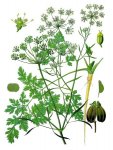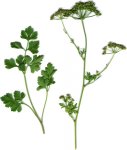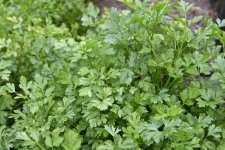Parsley
Petroselinum sativum Hoffm.
Botanical characteristics. Family umbrella. A biennial herbaceous plant with a branching thin stem, 50-100 cm high. The root is vertical, fleshy, with a white rim. Leaves long-petioled, lower - twice- and three-pinnate with trifoliate leaves, upper membranous. Greenish-yellow flowers are collected in complex umbrellas. Blooms in July-September, fructifies in August-September. Fruit is a greenish-brown double-seeded.
Spread. Spice is grown for the sake of roots and leaves in most of Russia.
Used parts of the plant.
Roots, grass and seeds.
The aroma of parsley is due to the content of essential oil (2-7%), in addition, the fruit of the plant found glycoside apiin and fatty oil (20%). The composition of essential oil includes apion, pinene and other terpenes, allyltetraxybenzene and phenols.
Application.
First of all, it is popular as a strong diuretic for diseases of the genito-urinary organs, especially urolithiasis, with swelling of various etiologies, as well as some infectious diseases (scarlet fever, measles, chicken pox). Infusion of herbs works favorably for liver disease, dyspepsia and flatulence.
In folk medicine, parsley is considered an abortifacient.
Contraindications. Pregnancy.
Preparation. Insist 1-2 tablespoons of herb per 0.5 liters of boiling water - daily dose.
Homeopathy uses Petroselinum 3x, 3 for diseases of the urinary tract. A characteristic symptom: sudden and strong urge to urinate.





Comments
When commenting on, remember that the content and tone of your message can hurt the feelings of real people, show respect and tolerance to your interlocutors even if you do not share their opinion, your behavior in the conditions of freedom of expression and anonymity provided by the Internet, changes Not only virtual, but also the real world. All comments are hidden from the index, spam is controlled.